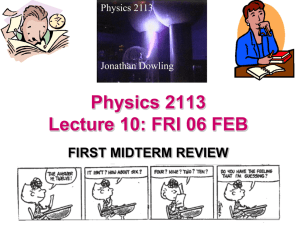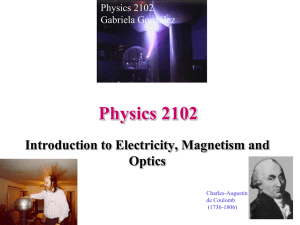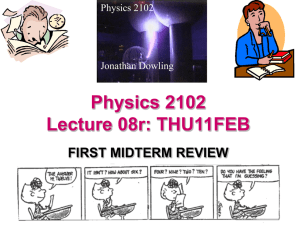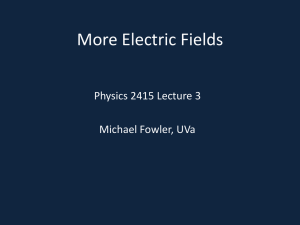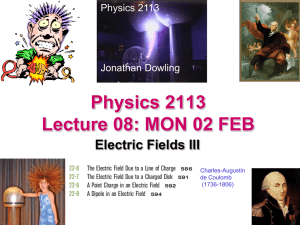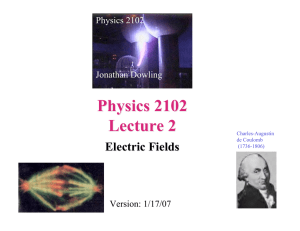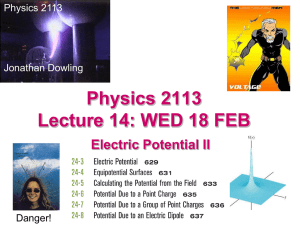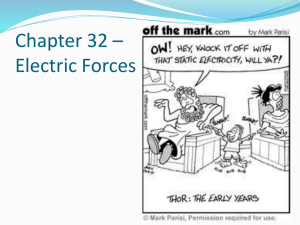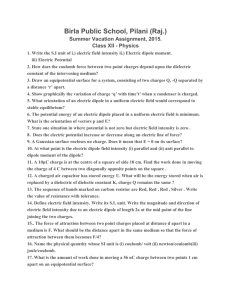PPT
advertisement
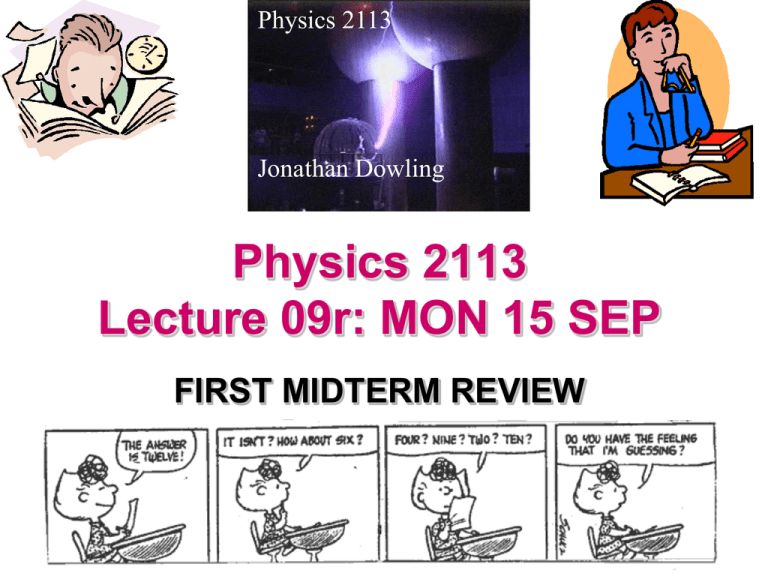
Physics 2113 Jonathan Dowling Physics 2113 Lecture 09r: MON 15 SEP FIRST MIDTERM REVIEW A few concepts: electric force, field and potential • Gravitational Force – What is the force on a mass produced by other masses? – Kepler’s Laws & Circular Motion • Gravitational Potential Energy • – Conservation of Energy • Electric force: – What is the force on a charge produced by other charges? – What is the force on a charge when immersed in an electric field? • Electric field: – What is the electric field produced by a system of charges? (Several point charges, or a continuous distribution) Plus a few other items… • Electric field lines • Electric dipoles: field and potential produced BY a dipole, torque ON a dipole by an electric field, torque and potential energy of a dipole Conservation of Mechanical Energy! Conservation of Mechanical Energy! Kepler’s Laws and Orbitronics for Circular Motion Charged Insulators & Conductors • Will two charged objects attract or repel? • Can a charged object attract or repel an uncharged object? Electric forces and fields: point charges Figure 22N-14 shows an arrangement of four charged particles, with angle q = 34° and distance d = 2.20 cm. The two negatively charged particles on the y axis are electrons that are fixed in place; the particle at the right has a charge q2 = +5e (a) Find distance D such that the net force on the particle at the left, due to the three other particles, is zero. (b) If the two electrons were moved further from the x axis, would the required value of D be greater than, less than, or the same as in part (a)? Other possible questions: what’s the electric field produced by the charges XXX at point PPP ? what’s the electric potential produced by the charges XXX at point PPP ? What’s the potential energy of this system? Electric dipoles • What’s the electric field at the center of the dipole? On axis? On the bisector? far away? • What is the force on a dipole in a uniform field? • What is the torque on a dipole in a uniform field? • What is the potential energy of a dipole in a uniform field? Electric fields of distributed charges Possible problems, questions: • What’s the electric field at the center of a charged circle? • What’s the electric field at the center of ¼ of a charged circle? • What’s the electric field far from the ring? far from the disk? • What’s the DIRECTION of an electric field of an infinite disk? Exam Review Continued • Questions: from checkpoints and questions in the textbook! Problem • Calculate electric field at point P. E x P dx L • Field very far away? a Problem Field at center of arc? Line Of Charge: Field on bisector dE Distance Charge per unit length P k (dq ) dE = d2 a dq dx Q x o L q l= L d = a2 + x2 k (l dx)a dE y = dE cosq = 2 2 3/ 2 (a + x ) a cosq = 2 2 1/ 2 (a + x ) Line Of Charge: Field on bisector L/2 L/2 dx é ù x E y = kl a ò 2 2 3 / 2 = kl a ê 2 2 2ú ( a + x ) ë a x + a û -L / 2 -L / 2 = 2klL a 4a + L 2 2 What is E very far away from the line (L<<a)? Ey~2klL/a(2a)=klL/a2=kq/a2 What is E if the line is infinitely long (L >> a)? 2klL 2kl Ey = = 2 a a L Electric fields: Example Calculate the magnitude and direction of the electric field produced by a ring of charge Q and radius R, at a distance z on its axis. Sample Problem Figure 22N-14 shows an arrangement of four charged particles, with angle q = 34° and distance d = 2.20 cm. The two negatively charged particles on the y axis are electrons that are fixed in place; the particle at the right has a charge q2 = +5e (a)Find distance D such that the net force on the particle at the left, due to the three other particles, is zero. (b) If the two electrons were moved further from the x axis, would the required value of D be greater than, less than, or the same as in part (a)?
